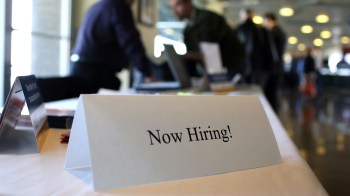Economy adds 431,000 new jobs in May
The Labor Department says the U.S. produced 431,000 jobs in May, a jobless rate drop of 9.7% over 9.9% in April. Only 20,000 jobs were created in the private sector, a considerable drop from the 230,000 private-sector jobs created in April. The vast majority of the remaining 411,000 jobs were from the temporary hiring of U.S. Census workers.
Economist Chris Low with FTN Financial notes the slowdown was broad-based. “We had slowdown in manufacturing hiring, a big drop in construction hiring, and then on the service side, the smallest job growth since December, mostly because of a job growth in retail and financial hiring.”
Analysts were disappointed that the number of jobs created fell short of previously-made healthy projections, as we’ve been seeing job growth of about triple May’s numbers for the past three months. Private-sector job numbers were considered particularly anemic; Census jobs only last about two weeks and can’t be roped into long-term numbers. In order to kickstart employment recovery and catch up to where we were before we lost 8-10 million jobs in the recession, we would need between 200,000 and 300,000 private-sector jobs created every month for several years, says Marketplace’s Mitchell Hartman.
But Economics Professor James Brock at Miami University in Ohio says despite not being a robust number, the broad trend is not that bad. “The unemployment rate is continuing to go down rather than go up, and we are creating tens of thousands of jobs, which I think is better than cutting hundreds of thousands of jobs.”
Will jobs slowdown continue?
Low doesn’t see the slowdown in job growth as permanent. “Employers are nervous. They’re nervous about what’s happening in Europe, they’re nervous about an engineered slowdown in China, and they’re trying to make due with fewer people.”
Low also says the increase of workweek aggregate hours is also good news. “[Employers] are increasing output and they’re trying to make due with fewer people. Right now that translates to productivity growth.” He also notes that with average hourly earnings up higher than expected, “there should be enough income growth to keep consumption going forward.”
Will lackluster jobs numbers continue? Hartman notes that temporary Census workers will soon be unemployed and looking for work. Shrinking budgets are also forcing state and local governments to cut teachers and DMV clerks, and more people who left the labor force and gave up on the job hunt because it was so dismal are coming back. These factors will probably push the unemployment rate back up toward 10 percent again later this year.
Marketplace economics correspondent says that expanded government programs and public sector jobs are a growing trend and that the public sector will keep growing more slowly than private sector. “The federal government is under enormous pressure to retrench with the budget deficits and debt we have, so growth has to come from private sector and our economy.”
Are unemployment benefits helping or hurting?
One major concern about the job market is the rising number of the long-term unemployed and how to deal with long-term unemployment benefits. Marketplace’s Alisa Roth notes that the debate is two-sided: Left-leaners generally say those who don’t have jobs need unemployment benefits until they can find a job, while those in the right-leaning camp say unemployment benefits are a disincentive to looking for work.
Economist Heather Boushey at the Center for American Progress says May’s disappointing job numbers should really be a call for policy makers to extend the benefits once and for all. “Those extended benefits not only help workers and their families, but they will help to support local economies by putting dollars into them.”
Economic growth encourages investor risk
While the global economy seems to be improving, investors are ready to take on more risk and venture away from safe-bet investments like U.S. Treasury Bonds.
“We’ve had one hell of a rally in the bond market,” says Marilyn Cohen, president of Envision Capital Management. She says the flight to safety allowed the Treasury Department to sell government debt cheap. But now that the economy is showing signs of recovery, buyers of Treasury notes are turning to riskier investments with potentially higher returns. So yields on those notes have started to climb.
“There will come a time when the institutional investor, who is really the 800-pound gorilla, will say, ‘You know what, I really have no interest in a 10-year Treasury. I’m going into the equity market or I’m going into commodities and or other things,'” Cohen says.
Cohen says that would force Treasury to offer more enticing returns on government debt to investors. Presumably, though, a stronger economy would also generate more government revenue, and therefore less debt, assuming politicians can control spending.
There’s a lot happening in the world. Through it all, Marketplace is here for you.
You rely on Marketplace to break down the world’s events and tell you how it affects you in a fact-based, approachable way. We rely on your financial support to keep making that possible.
Your donation today powers the independent journalism that you rely on. For just $5/month, you can help sustain Marketplace so we can keep reporting on the things that matter to you.


















